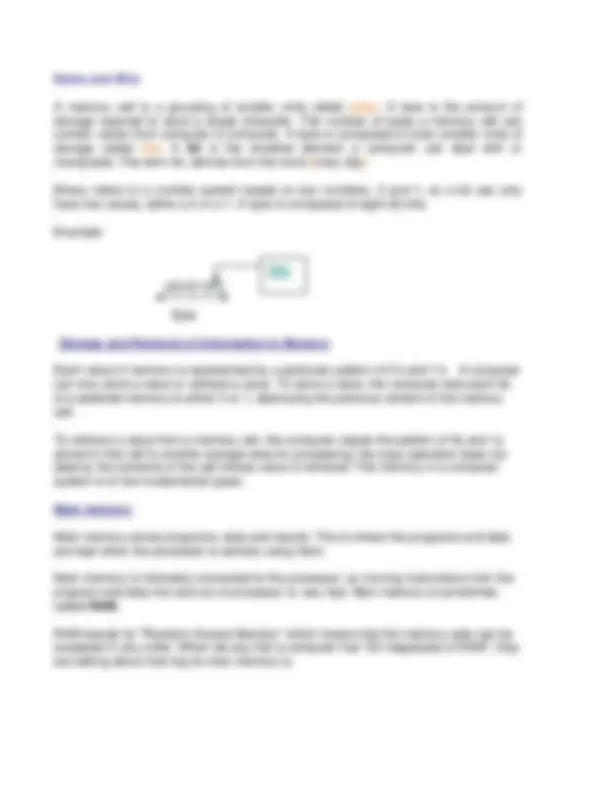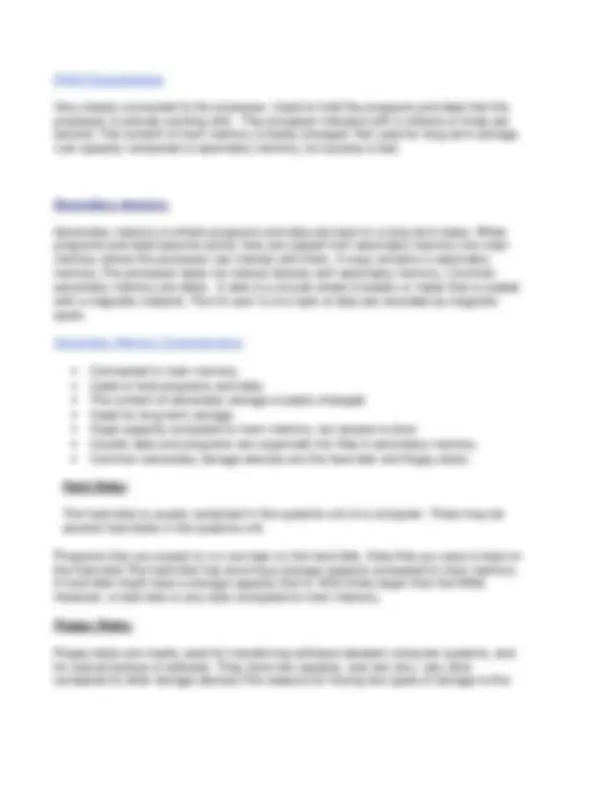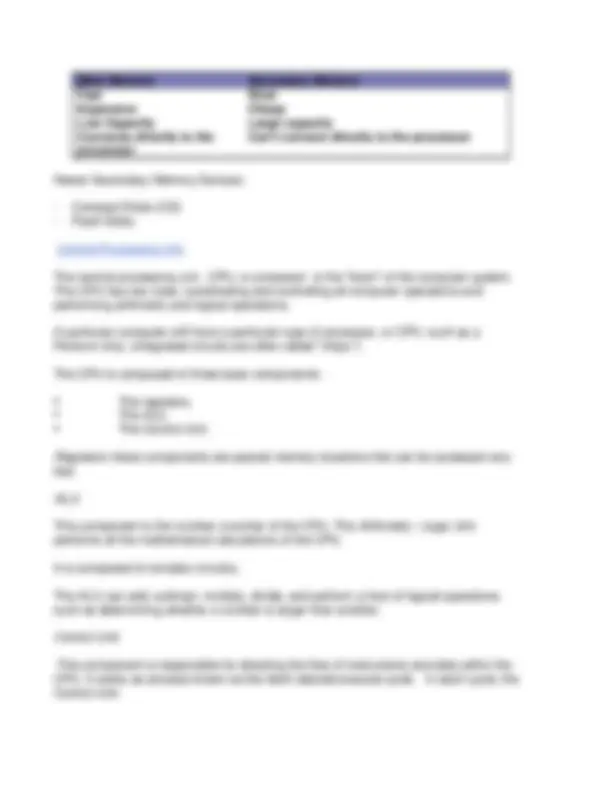





Study with the several resources on Docsity

Earn points by helping other students or get them with a premium plan


Prepare for your exams
Study with the several resources on Docsity

Earn points to download
Earn points by helping other students or get them with a premium plan
Community
Ask the community for help and clear up your study doubts
Discover the best universities in your country according to Docsity users
Free resources
Download our free guides on studying techniques, anxiety management strategies, and thesis advice from Docsity tutors
An overview of computers, explaining what they are, their major components, and the role of hardware and software. It covers the definition of a computer, the distinction between micro, mini, and supercomputers, and the introduction to computer memory, including bytes, bits, and the storage and retrieval process. The text also discusses the central processing unit (cpu), input and output devices, and computer software, specifically the operating system.
Typology: Study notes
1 / 7

This page cannot be seen from the preview
Don't miss anything!




Overview of Computers
What is a Computer?
A computer is an electronic device that can store, retrieve and process data at speed millions or billions times faster than a human.
Modern-day computers are categorized according to their size and performance.
Microcomputers are the most common computers.
They are used by a single person at a time, they are single user.
The largest microcomputers are called workstations.
Mini-computers or mainframes are used by research labs or businesses and are larger and faster than workstations. They are multi-user.
Supercomputers are the most powerful mainframes computers. They are specialized computers used for high-speed computations.
They are mostly used by the Army and NASA.
A Computer System is composed of two major elements: hardware and software.
The various devices that comprise a computer system are referred to as hardware.
Hardware is the equipment used to perform computations
The programs that run on a computer are called software.
Software consists of the programs that enable us to use and solve problems with a computer.
Computer Hardware:
The major hardware components of a computer system are common to most computers and are:
Main memory Secondary memory devices Central Processing Unit or CPU. Input devices Output devices
The CPU, main memory, and secondary memory devices are usually contained in the systems unit. This rectangular box is sometimes called "the computer."
The monitor is the TV-like screen.
Memory
Memory is an essential component of any computer. It is where the data and programs used by the computer are stored. In order to be able to use any piece of information, a computer must store it first.
What is Memory?
We can imagine the memory of a computer as an ordered sequence of storage locations called memory cells.
To store and access information, the computer must have a way of identifying the individual memory cells.
Therefore, each memory cell has a unique address that indicates its relative position in memory.
Most computers have millions of individual memory cells, each with it own address.
The data stored in a memory cell are called the content of the cell. Table below shows an example of a computer memory consisting of a 1000 cells with addresses from 0 to 999:
Address Contents 0 -27. 1 345 2 00. 3 C 4 - 5 H . . . .
RAM Characteristics
Very closely connected to the processor. Used to hold the programs and data that the processor is actively working with. The processor interacts with it millions of times per second. The content of main memory is easily changed. Not used for long-term storage. Low capacity compared to secondary memory, but access is fast.
Secondary memory:
Secondary memory is where programs and data are kept on a long-term basis. When programs and data become active, they are copied from secondary memory into main memory where the processor can interact with them. A copy remains in secondary memory.The processor does not interact directly with secondary memory. Common secondary memory are disks. A disk is a circular sheet of plastic or metal that is coated with a magnetic material. The 0’s and 1s of a byte of data are recorded as magnetic spots.
Secondary Memory Characteristics:
Hard Disks :
The hard disk is usually contained in the systems unit of a computer. There may be several hard disks in the systems unit.
Programs that you expect to run are kept on the hard disk. Data that you save is kept on the hard disk.The hard disk has enormous storage capacity compared to main memory. A hard disk might have a storage capacity that is 100s times larger than the RAM. However, a hard disk is very slow compared to main memory.
Floppy Disks:
Floppy disks are mostly used for transferring software between computer systems, and for casual backup of software. They have low capacity, and are very, very slow compared to other storage devices.The reasons for having two types of storage is this
Main Memory Secondary Memory Fast Slow Expensive Cheap Low Capacity Large capacity Connects directly to the processor
Can't connect directly to the processor
Newer Secondary Memory Devices:
Central Processing Unit
The central processing unit , CPU, or processor is the "brain" of the computer system. The CPU has two roles: coordinating and controlling all computer operations and performing arithmetic and logical operations.
A particular computer will have a particular type of processor, or CPU such as a Pentium chip. (Integrated circuits are often called "chips.")
The CPU is composed of three basic components:
The registers, The ALU, The Control Unit.
Registers : these components are special memory locations that can be accessed very fast.
ALU :
This component is the number cruncher of the CPU. The A rithmetic / L ogic U nit performs all the mathematical calculations of the CPU.
It is composed of complex circuitry.
The ALU can add, subtract, multiply, divide, and perform a host of logical operations such as determining whether a number is larger than another.
Control Unit :
This component is responsible for directing the flow of instructions and data within the CPU. It works as process known as the fetch-decode-execute cycle. In each cycle, the Control Unit:
An OS that uses a command-line interface displays a brief message called a prompt that indicates it is ready to receive input. The user then types a command at the keyboard.
Some tasks that the operating system performs: